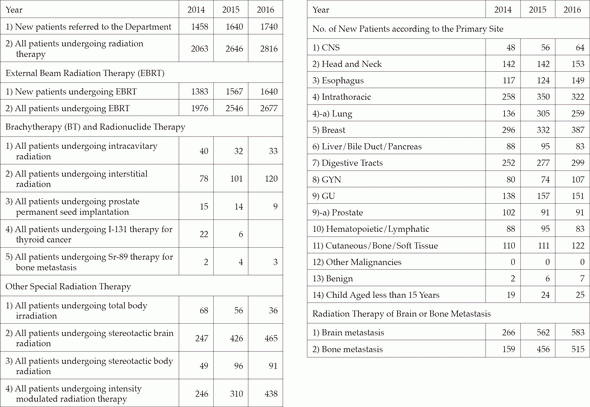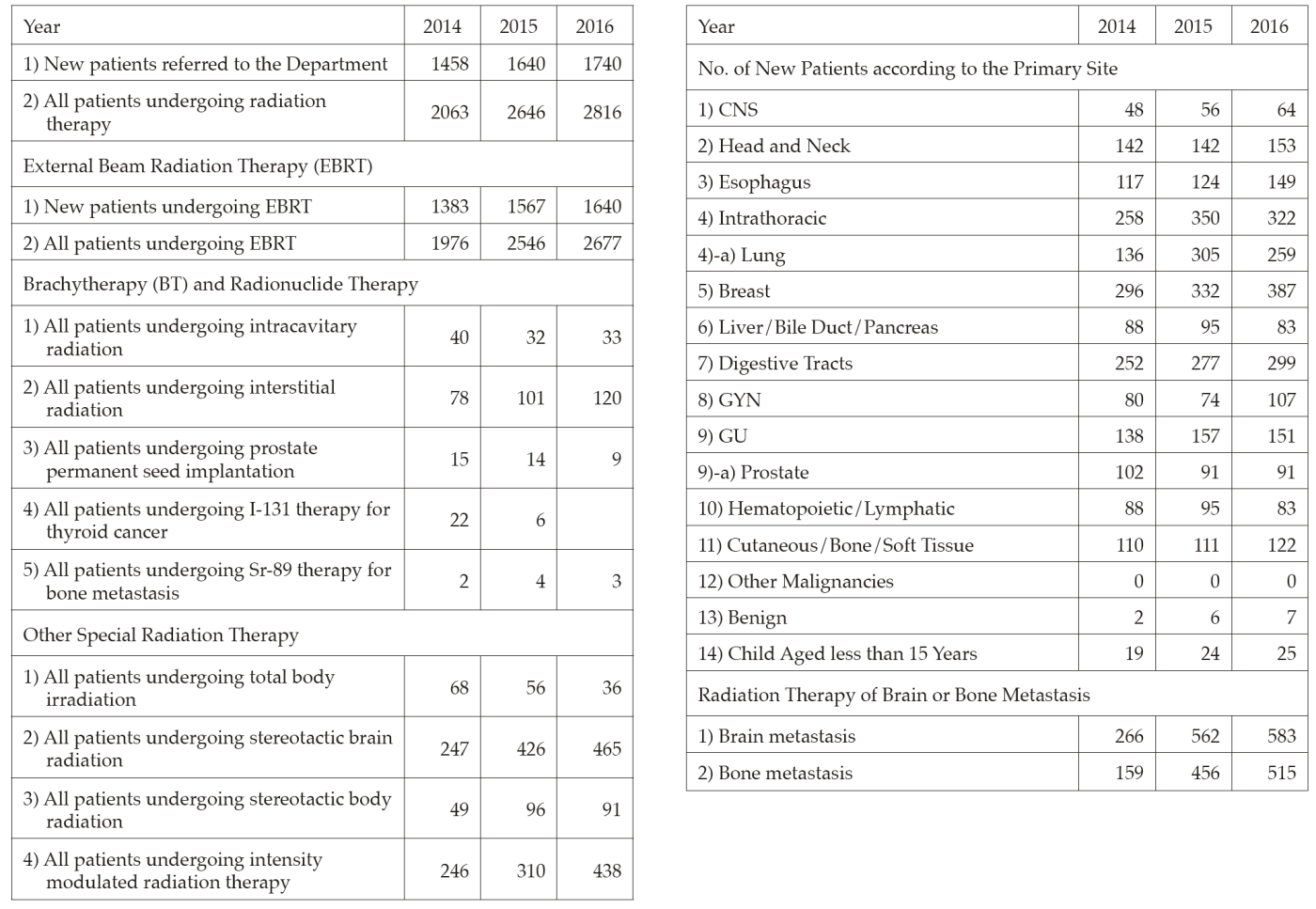HOME > Publication & Reports > Annual Report 2016 > Hospital
Department of Radiation Oncology
Jun Itami, Yoshinori Ito, Hiroshi Igaki, Naoya Murakami, Koichi Inaba, Kana Takahashi, Rei Umezawa, Shuhei Sekii, Mayuka Kitaguchi, Ken Harada, Kazuma Kobayashi, Hiroyuki Okamoto, Akihisa Wakita, Satoshi Nakamura, Shie Nishioka
Introduction
The role of our department is to provide state-of-the-art radiation therapy to all relevant patients, to educate and develop the expertise of radiation oncologists, radiation technologists, and medical physicists, and to lead new developments in radiation oncology in Japan as well as worldwide. All departmental activities are dedicated to cancer patients. A linear accelerator for hospital-based boron neutron capture therapy (BNCT) was installed to the new facility and an epithermal neutron beam was obtained already in August of 2015, and the neutron facility passed the governmental inspection for radiation leakage. Now the stability of BNCT accelerator is explored, while physical and biological experiments already being launched. Our department is now fully involved in the development of BNCT.
Our team and what we do
The Department of Radiation Oncology of the National Cancer Center Hospital is one of the biggest radiation oncology departments in Japan. Five linear accelerators, CyberKnife, one X-ray simulator, three XCT-simulators, and 15 treatment planning computers are working together through on-line networks to provide state-of-the-art precision external beam radiation therapy. In addition to the conventional X-ray and electron therapies, stereotactic irradiations of brain and body tumors, and intensity-modulated radiation therapy (IMRT) are performed routinely. Stereotactic brain irradiation is performed with CyberKnife in the treatment of metastatic as well as primary brain tumors. Stereotactic body tumor irradiation is performed in lung and liver tumors under respiratory gating in linear accelerators or CyberKnife. Four of the five linear accelerators have on-board kilovoltage CT imagers, which help to precisely align patient and tumor coordinates. These image image-guided radiation therapy (IGRT) facilities enable the precise delivery of IMRT in head and neck cancers, brain tumors, prostate cancers, and postoperative cervical cancers. Gold marker fiducials have been implanted to improve geometric precision of radiation field reproducibility. In 2016, linear accelerator No. 14 was replaced with ViewRay, fifth in the world and first in Japan, which enables MRI-guided adaptive therapy.
Brachytherapy is also performed very intensively to improve local control and many patients are referred to from all over Japan. For brachytherapy, the following modalities are being employed: an Ir-192 high dose rate (HDR) afterloading system including dedicated CT simulator and fluoroscopy, an I-125 seed implantation system, and other low dose rate (LDR) brachytherapy systems using Au grains, Ir-thin wires, and ruthenium eye plaques. The number of patients undergoing HDR brachytherapy continued to rise constantly. Our department is the only institution in Tokyo where HDR interstitial as well as intracavitary irradiations can be performed. HDR interstitial radiation is performed mainly in gynecological, genitourinary, and head and neck tumors. Additionally, there are two beds in the shielded ward on Floor 13B. Ruthenium mold therapy is performed by ophthalmologists to treat retinoblastomas and choroidal melanomas. LDR interstitial implants are carried out by radiation oncologists using Au-198 grains and Ir-192 thin wires for the management of head and neck tumors and gynecological malignancies.
Research activities
Clinical research is an indispensable part of the daily activities of our department. The primary interests of the research activities of our department are 1) an optimal fractionation regimen for the pain palliation of bone metastasis; 2) the safety and feasibility of shortened fractionation regimen for various malignancies, especially for breast cancer and vocal cord cancer; 3) Image-guided HDR and LDR brachytherapy for genitourinary and gynecologic cancers; 4) hypofractionated stereotactic irradiation of brain and body tumors; 5) adaptive radiation therapy in accordance with the intratherapeutic tumor and normal tissue change; and 6) development of an accelerator-based BNCT system.
Clinical trials
- Metastatic brain tumor:
Phase II trial of hippocampal sparing IMRT
- Lung cancer:
Various JCOG (The Japan Clinical Oncology Group) studies
- Lung cancer:
Stereotactic radiation therapy for histologically non-verified lung tumors.
- Pediatrics:
Phase II clinical trial on multimodality therapy in localized Ewing sarcomas and related tumors (JESS 04).
- Head and Neck cancers:
Various JCOG studies including IMRT for nasopharyngeal and oropharyngeal cancers
- Breast cancer:
Phase II trial of SAVI applicator HDR brachytherapy after partial mastectomy.
- Liver cancer:
Phase I trial on stereotactic hypofractionated radiation to hepatocellular carcinoma.
- Cervical cancer:
Phase I/II trial of hybrid brachytherapy of cervical cancer
- F-BPA PET/CT:
Feasibility study of F-BPA PET/CT in detecting malignancies with comparison to FDG PET/CT.
- Development of an Adaptive Radiation Therapy System
Education
Five residents were trained in all fields of radiation oncology except particle beam therapy. Seminars about biology, physics, and clinical radiation oncology were regularly held in the evenings. This year, trainees from Brazil and Myanmar studied and researched in our department.
Future prospects
With the expanding indications of radiation therapy, new manpower will be required and research perspectives will be greatly widened. Radiation oncology is one of the most promising disciplines in oncology.
List of papers published in 2016
Journal
1.Kobayashi K, Matsumoto F, Kodaira M, Mori T, Murakami N, Yoshida A, Maki D, Teshima M, Fukasawa M, Itami J, Asai M, Yoshimoto S. Significance of delayed primary excision in localized nonmetastatic adult head and neck rhabdomyosarcoma. Cancer Med, 5:2708-2714, 2016
2.Okamoto H, Wakita A, Nakamura S, Nishioka S, Aikawa A, Kato T, Abe Y, Kobayashi K, Inaba K, Murakami N, Itami J. Dosimetric impact of an air passage on intraluminal brachytherapy for bronchus cancer. J Radiat Res, 57:637-645, 2016
3.Murakami N, Kato S, Nakano T, Uno T, Yamanaka T, Sakurai H, Yoshimura R, Hiratsuka J, Kuroda Y, Yoshio K, Itami J. A phase I/II clinical trial for the hybrid of intracavitary and interstitial brachytherapy for locally advanced cervical cancer. BMC Cancer, 16:640, 2016
4.Kobayashi K, Murakami N, Inaba K, Wakita A, Nakamura S, Okamoto H, Sato J, Umezawa R, Takahashi K, Igaki H, Ito Y, Shigematsu N, Itami J. Dose reconstruction technique using non-rigid registration to evaluate spatial correspondence between high-dose region and late radiation toxicity: a case of tracheobronchial stenosis after external beam radiotherapy combined with endotracheal brachytherapy for tracheal cancer. J Contemp Brachytherapy, 8:156-163, 2016
5.Inaba K, Okamoto H, Wakita A, Tsuchida K, Kashihara T, Kobayashi K, Harada K, Kitaguchi M, Sekii S, Umezawa R, Takahashi K, Murakami N, Ito Y, Igaki H, Uno T, Itami J. Long-term observations of radiation-induced creatinine clearance reduction and renal parenchymal volume atrophy. Radiother Oncol, 120:145-149, 2016
6.Kobayashi K, Kurihara H, Watanabe Y, Murakami N, Inaba K, Nakamura S, Wakita A, Okamoto H, Umezawa R, Takahashi K, Igaki H, Ito Y, Yoshimoto S, Shigematsu N, Itami J. In vivo spatial correlation between 18F-BPA and 18F-FDG uptakes in head and neck cancer. Appl Radiat Isot, 115:138-146, 2016
7.Kawajiri A, Maruyama D, Maeshima AM, Nomoto J, Makita S, Kitahara H, Miyamoto KI, Fukuhara S, Suzuki T, Munakata W, Tajima K, Itami J, Taniguchi H, Kobayashi Y, Tobinai K. Impact of the double expression of MYC and BCL2 on outcomes of localized primary gastric diffuse large B-cell lymphoma patients in the rituximab era. Blood Cancer J, 6:e477, 2016
8.Murakami N, Kato T, Miyamoto Y, Nakamura S, Wakita A, Okamoto H, Tsuchida K, Kashihara T, Kobayashi K, Harada K, Kitaguchi M, Sekii S, Takahashi K, Umezawa R, Inaba K, Ito Y, Igaki H, Itami J. Salvage High-dose-rate Interstitial Brachytherapy for Pelvic Recurrent Cervical Carcinoma After Hysterectomy. Anticancer Res, 36:2413-2421, 2016
9.Murakami N, Kobayashi K, Kato T, Nakamura S, Wakita A, Okamoto H, Shima S, Tsuchida K, Kashihara T, Harada K, Takahashi K, Umezawa R, Inaba K, Ito Y, Igaki H, Itami J. The role of interstitial brachytherapy in the management of primary radiation therapy for uterine cervical cancer. J Contemp Brachytherapy, 8:391-398, 2016
10.Murakami N, Matsumoto F, Yoshimoto S, Ito Y, Mori T, Ueno T, Tuchida K, Kashihara T, Kobayashi K, Harada K, Kitaguchi M, Sekii S, Umezawa R, Takahashi K, Inaba K, Igaki H, Itami J. Patterns of recurrence after selective postoperative radiation therapy for patients with head and neck squamous cell carcinoma. BMC Cancer, 16:192, 2016
11.Nakamura S, Murakami N, Inaba K, Wakita A, Kobayashi K, Takahashi K, Okamoto H, Umezawa R, Morota M, Sumi M, Igaki H, Ito Y, Itami J. After low and high dose-rate interstitial brachytherapy followed by IMRT radiotherapy for intermediate and high risk prostate cancer. BMC Cancer, 16:296, 2016
12.Okamoto H, Hamada M, Sakamoto E, Wakita A, Nakamura S, Kato T, Abe Y, Takahashi K, Igaki H, Itami J. Log-file analysis of accuracy of beam localization for brain tumor treatment by CyberKnife. Pract Radiat Oncol, 6:e361-e367, 2016
13.Takahashi K, Morota M, Kagami Y, Okamoto H, Sekii S, Inaba K, Murakami N, Igaki H, Ito Y, Uno T, Itami J. Prospective study of postoperative whole breast radiotherapy for Japanese large-breasted women: a clinical and dosimetric comparisons between supine and prone positions and a dose measurement using a breast phantom. BMC Cancer, 16:757, 2016
14.Inaba K, Nakamura S, Okamoto H, Kashihara T, Kobayashi K, Harada K, Kitaguchi M, Sekii S, Takahashi K, Murakami N, Ito Y, Igaki H, Uno T, Itami J. Early-onset dropped head syndrome after radiotherapy for head and neck cancer: dose constraints for neck extensor muscles. J Radiat Res, 57:169-173, 2016
15.Nose T, Otani Y, Asahi S, Tsukiyama I, Dokiya T, Saeki T, Fukuda I, Sekine H, Shikama N, Kumazaki Y, Takahashi T, Yoshida K, Kotsuma T, Masuda N, Yoden E, Nakashima K, Matsumura T, Nakagawa S, Tachiiri S, Moriguchi Y, Itami J, Oguchi M. A Japanese prospective multi-institutional feasibility study on accelerated partial breast irradiation using interstitial brachytherapy: clinical results with a median follow-up of 26 months. Breast Cancer, 23:861-868, 2016


